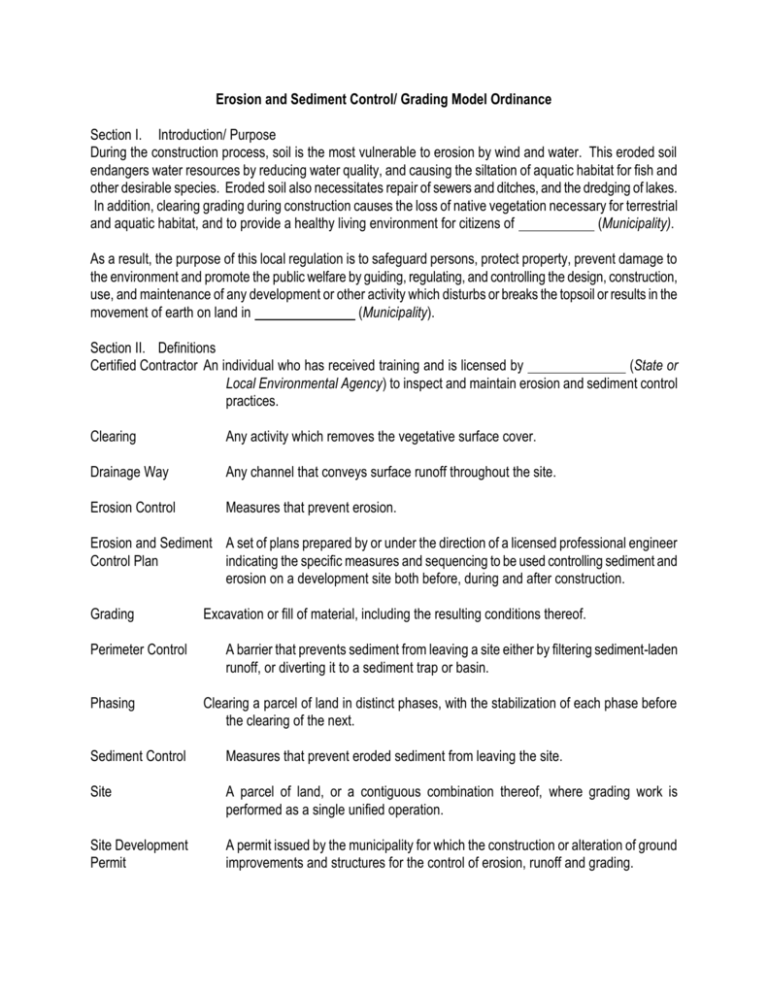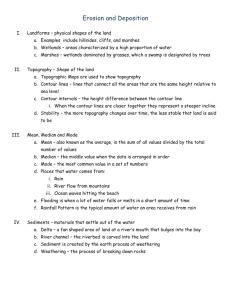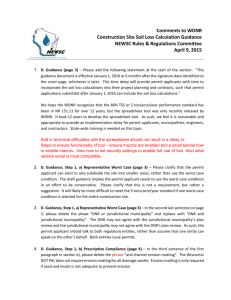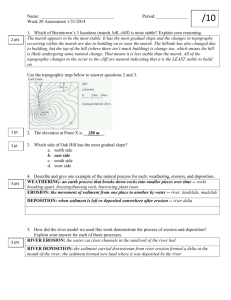Erosion and Sediment Control/ Grading Model Ordinance
advertisement

Erosion and Sediment Control/ Grading Model Ordinance Section I. Introduction/ Purpose During the construction process, soil is the most vulnerable to erosion by wind and water. This eroded soil endangers water resources by reducing water quality, and causing the siltation of aquatic habitat for fish and other desirable species. Eroded soil also necessitates repair of sewers and ditches, and the dredging of lakes. In addition, clearing grading during construction causes the loss of native vegetation necessary for terrestrial and aquatic habitat, and to provide a healthy living environment for citizens of (Municipality). As a result, the purpose of this local regulation is to safeguard persons, protect property, prevent damage to the environment and promote the public welfare by guiding, regulating, and controlling the design, construction, use, and maintenance of any development or other activity which disturbs or breaks the topsoil or results in the movement of earth on land in (Municipality). Section II. Definitions Certified Contractor An individual who has received training and is licensed by (State or Local Environmental Agency) to inspect and maintain erosion and sediment control practices. Clearing Any activity which removes the vegetative surface cover. Drainage Way Any channel that conveys surface runoff throughout the site. Erosion Control Measures that prevent erosion. Erosion and Sediment A set of plans prepared by or under the direction of a licensed professional engineer Control Plan indicating the specific measures and sequencing to be used controlling sediment and erosion on a development site both before, during and after construction. Grading Perimeter Control Phasing Excavation or fill of material, including the resulting conditions thereof. A barrier that prevents sediment from leaving a site either by filtering sediment-laden runoff, or diverting it to a sediment trap or basin. Clearing a parcel of land in distinct phases, with the stabilization of each phase before the clearing of the next. Sediment Control Measures that prevent eroded sediment from leaving the site. Site A parcel of land, or a contiguous combination thereof, where grading work is performed as a single unified operation. Site Development Permit A permit issued by the municipality for which the construction or alteration of ground improvements and structures for the control of erosion, runoff and grading. Stabilization The use of practices that prevent exposed soil from eroding. Start of Construction The first land-disturbing activity associated with a development, including land preparation such as clearing, grading and filling; installation of streets and walkways; excavation for basements, footings, piers or foundations; erection of temporary forms; and installation of accessory buildings such as garages. Watercourse Any body of water, including, but not limited to lakes, ponds, rivers, streams, and bodies of water which delineated by (Municipality). Waterway A channel that directs surface runoff to a watercourse, or to the public storm drain. 1. Permits 1. No person shall be granted a site development permit for land-disturbing activity which would require the uncovering of 10,000 or more square feet without the approval of an Erosion and Sediment Control Plan by (Erosion and Sediment Control Agency). The size of the site regulated under the erosion and sediment control ordinance varies widely. The proposed Phase II NPDES rules regulate disturbances greater than one acre, but communities regulate sites as small as 2,000 square feet. 2. No site development permit is required for the following activities: 1. Any emergency activity which is immediately necessary for the protection of life, property or natural resources. 2. Existing nursery and agricultural operations conducted as a permitted main or accessory use. Communities may choose to exempt other activities, such as mining, from an erosion and sediment control permit, or in some cases include the exempted uses cited above.. 3. Each application shall bear the name(s) and address(es) of the owner or developer of the site, and of any consulting firm retained by the applicant together with the name of the applicant’s principal contact at such firm, and shall be accompanied by a filing fee. 4. Each application shall include a statement that any land clearing, construction, or development involving the movement of earth shall be in accordance with the Erosion and Sediment Control Plan, and that a Certified Contractor shall be on site on all days where construction or grading activity takes place. Some states have "Certified Contractor" programs, in which contractors successfully completing a training course in basic erosion and sediment control. This individual would be responsible for ensuring the regular maintenance and proper installation of erosion and sediment control measures. 5. The applicant will be required to file with (Municipality) a faithful performance bond or bonds, letter of credit, or other improvement security in an amount deemed sufficient by (Erosion and Sediment Control Agency) to cover all costs of improvements, landscaping, and maintenance of improvements for such period as specified by (Municipality) and engineering and inspection costs to cover the cost of failure or repair of improvements installed on the site. 6. Review and approval 1. (Erosion and Sediment Control Agency) will review each application for a site development permit to determine its conformance with the provisions of this local regulation. Within thirty (30) days after receiving an application, (Erosion and Sediment Control Agency) shall, in writing: 1. approve the permit application; 2. approve the permit application subject to such reasonable conditions as may be necessary to secure substantially the objectives of this regulation, and issue the permit subject to these conditions; or 3. disapprove the permit application, indicating the deficiencies and the procedure for submitting a revised application and/or submission. 2. Failure of the (Erosion and Sediment Control Agency) to act on original or revised applications within thirty (30) days of receipt shall authorize the applicant to proceed in accordance with the plans as filed unless such time is extended by agreement between the applicant and (Erosion and Sediment Control Agency). Pending preparation and approval of a revised plan, development activities shall be allowed to proceed in accordance with conditions established by (Erosion and Sediment Control Agency). 2. Erosion and Sediment Control Plan 1. The Erosion and Sediment Control Plan shall include: 1. A natural resources map identifying soils, forest cover, and resources protected under other chapters of this code. This map should be at a scale no smaller than 1"=100'. For a more detailed discussion, see the buffer ordinance. 2. A sequence of construction of the development site, including stripping and clearing, rough grading, construction of utilities, infrastructure, and buildings, and final grading and landscaping. Sequencing shall identify the expected date on which clearing will begin, the estimated duration of exposure of cleared areas, and the sequence of clearing, installation of temporary erosion and sediment measures, and establishment of permanent vegetation. 3. All erosion and sediment control measures necessary to meet the objectives of this local regulation throughout all phases of construction and permanently, after completion of development of the site. Depending upon the complexity of the project, the drafting of intermediate plans may be required at the close of each season. 4. Seeding mixtures and rates, types of sod, method of seedbed preparation, expected seeding dates, type and rate of lime and fertilizer application, and kind and quantity of mulching for both temporary and permanent vegetative control measures. 5. Provisions for maintenance of control facilities, including easements and estimates of the cost of maintenance. 2. Modifications to the plan 1. Major amendments of the erosion and sediment control plan shall be submitted to (Erosion and Sediment Control Agency) and shall be processed and approved, or disapproved, in the same manner as the original plans. 2. Field modifications of a minor nature may be authorized by (Erosion and Sediment Control Agency) by written authorization to the permitee. 3. Design Requirements Grading, erosion control practices, sediment control practices, and waterway crossings shall meet the design criteria set forth in the most recent version of (Erosion and Sediment Control Manual), and shall be adequate to prevent transportation of sediment from the site to the satisfaction of (Erosion and Sediment Control Agency). 1. Clearing and Grading 1. Clearing and grading of natural resources, such as forests and wetlands, shall not be permitted, except when in compliance all other chapters of this Code. For example, the stream buffer codes as well as the forest conservation code in the "Miscellaneous" section would also restrict clearing. 2. Clearing techniques that retain natural vegetation and retain natural drainage patterns, as described in (Erosion and Sediment Control Manual), shall be used to the satisfaction of (Erosion and Sediment Control Agency). 3. Phasing shall be required on all sites disturbing greater than thirty acres, with the size of each phase to be established at plan review and as approved by (Erosion and Sediment Control Agency). While many communities encourage phasing, few actually require it. Phasing construction can reduce erosion significantly when well-designed. (See Claytor, 1997). 4. Clearing, except that necessary to establish sediment control devices, shall not begin until all sediment control devices have been installed and have been stabilized. 5. Cut and fill slopes shall be no greater than 2:1, except as approved by (Erosion and Sediment Control Agency) to meet other community or environmental objectives. 2. Erosion Control 1. Soil must be stabilized within five days of clearing or inactivity in construction. 2. If vegetative erosion control methods, such as seeding, have not become established within two weeks, (Erosion and Sediment Control Agency) may require that the site be reseeded, or that a non-vegetative option be employed. Numerical standards regarding the time to stabilization will vary. In particular, the time to establish seeding will depend on the climate. 3. On steep slopes or in drainage ways, special techniques that meet the design criteria outlined in (Erosion and Sediment Control Manual) shall be used to ensure stabilization. 4. Soil stockpiles must be stabilized or covered at the end of each work day. 5. At the close of the construction season, the entire site must be stabilized, using a heavy mulch layer, or another method that does not require germination to control erosion. 6. Techniques shall be employed to prevent the blowing of dust or sediment from the site. Dust control is most important in arid regions of the country 7. Techniques that divert upland runoff past disturbed slopes shall be employed. 3. Sediment Controls 1. Sediment controls shall be provided in the form of settling basins or sediment traps or tanks, and perimeter controls. 2. Where possible, settling basins shall be designed in a manner that allows adaptation to provide long term stormwater management. 3. Adjacent properties shall be protected by the use of a vegetated buffer strip, in combination with perimeter controls. 4. Waterways and Watercourses 1. When a wet watercourse must be crossed regularly during construction, a temporary stream crossing shall be provided, and an approval obtained from (Approving Agency, e.g., Waterways Division, ESC Agency). 2. When in-channel work is conducted, the channel shall be stabilized before, during and after work. 3. All on-site stormwater conveyance channels shall be designed according to the criteria outlined in (Erosion and Sediment Control Manual). 4. Stabilization adequate to prevent erosion must be provided at the outlets of all pipes and paved channels. 5. Construction Site Access 1. A temporary access road shall be provided at all sites. 2. Other measures may be required at the discretion of (Erosion and Sediment Control Agency) in order to ensure that sediment is not tracked onto public streets by construction vehicles, or washed into storm drains. 4. Inspection 1. (Erosion and Sediment Control Agency) or designated agent shall make inspections as hereinafter required and shall either approve that portion of the work completed or shall notify the permitee wherein the work fails to comply with the erosion and sediment control plan as approved. Plans for grading, stripping, excavating, and filling work bearing the stamp of approval of the (Erosion and Sediment Control Agency) shall be maintained at the site during the progress of the work. In order to obtain inspections, the permitee shall notify (Erosion and Sediment Control Agency) at least two (2) working days before the following: 1. Start of Construction 2. Erosion and sediment control measures are in place and stabilized. 3. Site Clearing has been completed 4. Rough Grading has been completed 5. Final Grading has been completed 6. Close of the Construction Season 7. Final Landscaping The "Certified Inspector Program" in Delaware allows developers to hire an inspector who has passed a state licensing program. This individual would inspect the site at regular intervals, and file reports to the erosion and sediment control agency. The agency would then be responsible for spot checks on these reports. 2. The permitee or his/her agent shall make regular inspections of all control measures in accordance with the inspection schedule outlined on the approved erosion and sediment control plan(s). The purpose of such inspections will be to determine the overall effectiveness of the control plan, and the need for additional control measures. All inspections shall be documented in written form and submitted to (Erosion and Sediment Control Agency) at the time interval specified in the approved permit. 3. 5. (Erosion and Sediment Control Agency) or its designated agent shall enter the property of the applicant as deemed necessary to make regular inspections to ensure the validity of the reports filed under Section B. Enforcement 1. Stop-Work Order; Revocation of Permit In the event that any person holding a site development permit pursuant to this ordinance violates the terms of the permit, or implements site development in such a manner as to materially adversely affect the health, welfare, or safety or persons residing or working in the neighborhood or development site so as to be materially detrimental to the public welfare or injurious to property or improvements in the neighborhood, (Erosion and Sediment Control Agency) may suspend or revoke the site development permit. 2. Violation and Penalties No person shall construct, enlarge, alter, repair, or maintain any grading, excavation, or fill, or cause the same to be done, contrary to or in violation of any terms of this ordinance. Any person violating any of the provisions of this ordinance shall be deemed guilty of a misdemeanor, and each day during which any violation of any of the provisions of this ordinance is committed, continued or permitted, shall constitute a separate offense. Upon conviction of any such violation, such person, partnership, or corporation shall be punished by a fine of not more than $ for each offense. In addition to any other penalty authorized by this section, any person, partnership, or corporation convicted of violating any of the provisions of this ordinance shall be 6. required to bear the expense of such restoration. Specific penalties will vary between communities, and should reflect realistically enforceable penalties given the political realities of a jurisdiction. Separability The provisions and sections of this ordinance shall be deemed to be separable, and the invalidity of any portion of this ordinance shall not affect the validity of the remainder. References Caraco, D. 1997. Delaware Program Improves Construction Site Inspection. Watershed Protection Techniques, 2(3): 440-442. Claytor, R. 1997. Practical Tips for Construction Site Phasing. Watershed Protection Techniques, 2(3): 413-417.








